The Woodlands of Hitachi High-Tech Science (Shizuoka)
The Fuji Oyama Works of Hitachi High-Tech Science (Sunto-county, Shizuoka Prefecture) has forested land approximately 44,000 m2 in area that has been named the Woodlands of Hitachi High-Tech Science. We have been conducting activities continuously since 2015 with the aim of working as a member of the local community to realize harmony with nature as well as to restore the forest to what it used to be under the traditional satoyama system of managing natural resources in the local environment as a part of the everyday lives of people living there.
Status of Activities
- News
Major Initiatives
(1) Maintenance and regeneration of a vast woodland
We will continue to maintain and regenerate the woodland that takes up 87% of the total area of our premises.
(2) Converting an artificial forest into a natural forest
Over the course of some 50 years, we will use plants that are native to the region to broadly transform the present artificial forest of Japanese cedar and Japanese cypress into a broad-leaved forest. We collected acorns from kunugi oak and konara oak trees on the property and cultivated seedlings to plant in a mix with a variety of other trees and return the forest to something more closely resembling its original natural state. The other trees include Japanese snowbell, mountain cherry, Japanese flowering dogwood, and Japanese maple, which are tall and medium-height trees, together with Japanese beautyberry, which is a shrub. Our aim is to restore the natural woodland as quickly as possible. This will also improve the ecology for wildlife such as the great tit (a bird) and the Pallas' Sailer (a butterfly).
![image: [Photographs] Acorns from kunugi oak and konara oak trees](/image/global/about/csr/environment/bio/hhs_woodlands/index_01.png)
![image: [Photographs] Acorns from kunugi oak and konara oak trees](/image/global/about/csr/environment/bio/hhs_woodlands/index_02.png )
[Photographs] Acorns from kunugi oak and konara oak trees
(3) Regenerating a zebra grass field where wild native grasses bloom
In order to convert a portion of the lawn into a semi-natural zebra grass field full of native grass, we have been dividing zebra grass roots for replanting since 2016. The area of the zebra grass field that took about 5 years to regenerate is about 1,400 m2.
In addition to maintaining the zebra grass area, our group has been observing native insects since 2022.
![image: [Photograph] Transition to grassland with Japanese pampas grass](/image/global/about/csr/environment/bio/hhs_woodlands/index_03.png )
[Photograph] Transition to grassland with Japanese pampas grass
(4) Eradication of invasive plants
We are continuously working to eradicate invasive plant species such as Canadian goldenrod and annual fleabane.
Vision for the Woodland of Hitachi High-Tech Science (changes in distribution of vegetation)
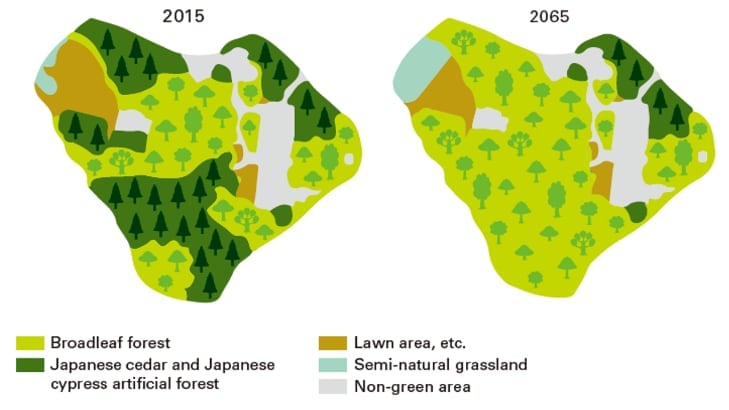
Vision for the Woodland of Hitachi High-Tech Science (ecosystem pyramid) Source:
Ecosystem Conservation Society-Japan
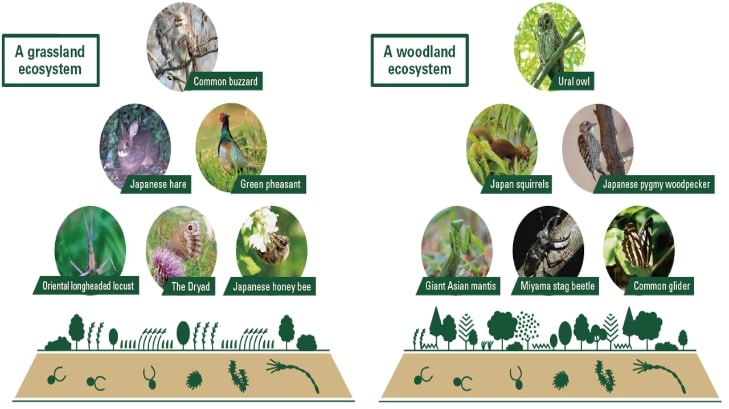
(5) Installation of insect hotels
Since fiscal 2021, we have been producing and installing insect hotels as habitats for insects to create an environment where nature wildlife, particularly insects, can live securely. In fiscal 2022, we observed and replenished tree branches and bamboo placed in existing insect hotels and produced and installed a second hotel. The frameworks of the hotels are made from waste materials used to transport products at the business site, and natural materials such as pinecones, wood, dead branches, bamboo, and dead leaves are collected by walking through the forest at the site and incorporated into the hotels.
Going forward, we will observe the status of use by insects over time and contribute to restoring the natural environment in order to nurture greater diversity of wildlife based on an understanding of the importance of establishing balance in ecosystems.
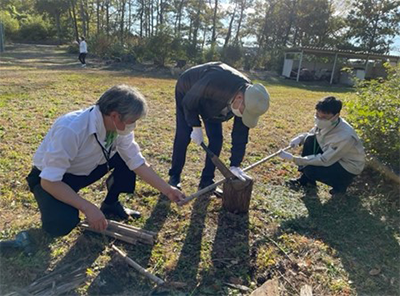
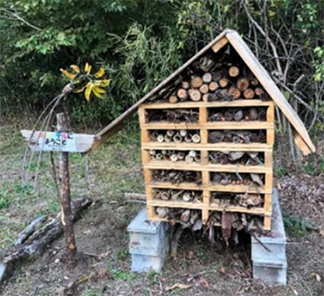
Obtaining Third-Party Certification in Biodiversity
Hitachi High-Tech Corporation received the highest rating of AAA under the JHEP certification system of the national organization "Ecosystem Conservation Society - Japan" for the "Woodlands of Hitachi High-Tech Science"(approx. 44,000 m2).
In 2015, Hitachi High-Tech Science's R&D facility became the first R&D facility in Japan to receive an AA+ rank under the JHEP certification system.
Then, continued efforts to preserve and restore biodiversity were evaluated very highly, leading to the "Woodlands of Hitachi High-Tech Science" project being awarded an AAA rating upon renewal every 5 years of the JHEP certification, the highest ranking possible.
The purpose of the "Woodlands of Hitachi High-Tech Science " is the restoration of a rich natural environment where a diverse range of species coexist. We will continue to strive to maintain and preserve biodiversity with our local communities and our employees.
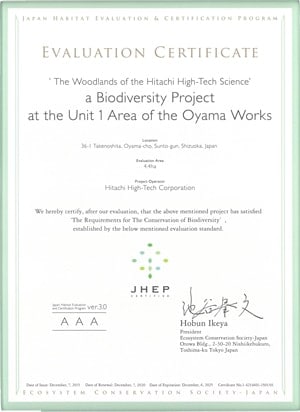
Message sent to Hitachi High-Tech on JHEP certification with the highest evaluation (AAA)
Congratulations on your JHEP AAA certification.
As with trees, wild grasses are also considered to be an important genetic resource for nature restoration.
I have seen the content of your company initiative, and I was very impressed to see both the conversion from simple planted forests of Japanese cedar and cypress to natural forests that take biodiversity into consideration and the regeneration of grasslands with wild grasses.
JHEP was originally developed in the United States and arranged for Japan. This is a "visualisation" of biodiversity.
In the first place, protecting biodiversity means protecting genetic resources, which are the basis for our survival.
Looking at the current state of biodiversity in Japan, it is actually a serious situation. For example, wild birds are decreasing sharply all over Japan.
Wild birds have decreased significantly since the beginning of the Meiji period and have continued to decrease since then. One of the reasons for the decrease in wild birds is thought to be the decrease in insects as their feeds. The loss of insects is thought to be caused by the loss of nature, the use of pesticides, and light pollution.
Biodiversity in Japan cannot be protected unless such factors are improved.
Among those situation, Hitachi High-Tech is engaged in the business of restoring nature on its own.
And this initiative would be a model in Japan. While SDGs and ESG investing are required worldwide, I am confident that such efforts will be highly valued internationally.
Ecosystem Conservation Society-Japan
President Hobun Ikeya
The Ministry of the Environment Nature Symbiosis Site Certification
The Woodlands of Hitachi High-Tech Science has been certified by the Ministry of the Environment as a Natural Symbiosis Site in the latter half of fiscal 2023—an area where "biodiversity is protected through private initiatives". Our employees have worked together with local communities to implement a wide range of initiatives for maintaining and preserving biodiversity in the Woodlands of Hitachi High-Tech Science, which has been evaluated and now certified.
The Ministry of the Environment has launched initiatives such as the 30by30 Alliance for Biodiversity* and certifying Natural Symbiosis Sites in service of achieving the target of 30by30, which aims to protect at least 30% of land and sea by 2030 in order to halt biodiversity losses and work toward reversing them (Nature Positive) agreed in 47th G7 Summit (June, 2021).
Hitachi High-Tech and Hitachi High-Tech Science have joined the 30by30 Alliance for Biodiversity and will continue its activities to maintain and preserve biodiversity in the Woodlands of Hitachi High-Tech Science as part of its efforts to create environmental value and contribute to a sustainable global environment throughout the Hitachi High-Tech Group.
* 30by30 Alliance for Biodiversity: The platform comprised of volunteer companies, local governments and organizations to promote and work together to achieve 30by30 target across Japan
![image: [Photographs] Certification ceremony](/global/en/media/bio_13_tcm27-233271.png)
